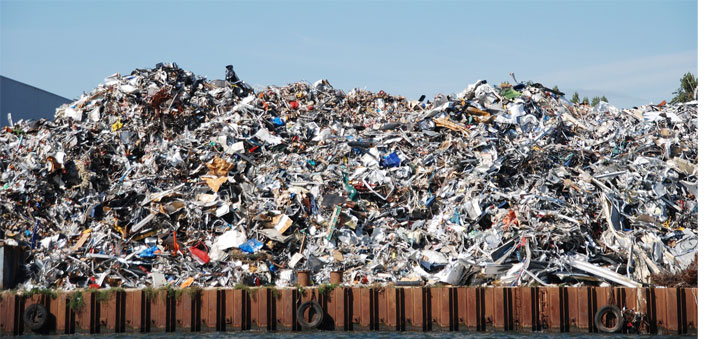Plastic cans, tins, paper plates, water bottles all neatly dumped in big black plastic bags and carried out – this was the spectacle that greeted me first when I went to board a flight recently. The flight crew took three such bags out before the passengers were given a clear signal to get inside the plane. During my two hour journey on board the flight, I saw more trash. Passengers asking for a glass of water/juice, tetra packs, meals, noodles in a cup – all generating sizeable amount of trash and I was left to wonder what happens to all this trash?
The aviation industry is a rapidly growing sector in our country and is soon aiming to reach the top three by 2020. Last year the domestic carriers carried around 100 million passengers, this inspite of the demonetisation move in November.
There are many reasons for this growth. Better regional connectivity, revise in aviation policies by the government, modernisation of airports, low cost carriers etc., are boosting the aviation Industry that at present occupies the ninth position in the civil aviation market in the world. With such rapid development and growth projected for the industry, the impact on the environment can no longer be side-lined. The waste from cabin, food etc., generated at every commercial flight is colossal – more so in long haul flights as compared to short haul flights.
Airport waste
So what kind of waste does an airport generate?
The Federal Aviation Administration in its recycling synthesis document mentions the following types of waste generated at the airport: Municipal Solid Waste (MSW), construction and demolition waste, green waste, food waste, deplaned waste, lavatory waste, hazardous waste and spill cleanup and remediation waste. The MSW encompasses food waste, green waste or yard waste, bottles, furniture etc. Hazardous waste consists of solvents, pesticides etc., while spill cleanup and remediation waste are generated due to clean up activities.

Airline waste
The deplaned waste is the waste generated inside the aircraft. Beverage cans, meal containers, plastic bottles and cans, newspapers, napkins, waste food, paper towels etc., to name a few. Paper waste, plastic items, polystyrene cups, food covers, account for the majority of the waste. Most of these can be easily recycled. Stuff like cardboard, plastic, aluminium etc. are recyclable. Paper waste can be segregated, sorted and recycled. Magazines and newspapers can be collected as well. Metals like aluminium cans, foils also can be recycled. Food waste that sometimes accounts for 20% of cabin waste can be recycled as well. Only thing is, it should not be mixed with non-recyclables and plastics. Instead, proper arrangements should be done to compost it. Plastic trays can be easily upcycled as well.
Challenges in managing waste
So what hinders the airlines from recycling and reducing its ecological footprint? Recycling, upcycling, reuse after all reduce waste and saves energy.
Most of the airports lack a proper disposal system to recycle waste. The recyclable waste gets mixed with the ones that cannot be recycled, and often get burnt. Or they may end up in landfills.
Plus there are other obstacles too.
• Airlines depend on airport facilities for waste management. Lack of proper facilities, low awareness among public, and the different participatory agencies enhance the problem further.
• Certain security rules don’t help either. For instance, the banning of water bottles at security. Many passengers opt to leave the bottles behind.
• Also there is no standard policy across airports on waste management. This means no centralised agency is taking responsibility.
• Airline operators, cabin crew and other agencies should also be educated on waste management principles.
Learning from foreign airlines
Airlines in India can take a cue from its foreign counterparts. United Airlines for instance, recycles its paper and plastic waste from flights and also upcycles its old banners into travel bags. Alaska Airlines recycles its cups and bottles and has plans to reduce its waste by 70% per passenger by 2020. UK airports like Heathrow and Stansted also have a 70% recycling goal. Some airports in UK also have an onsite waste to energy plant to generate energy from waste. While some airlines have green teams that lead environmental campaigns, some have partnered with recyclers to upcycle trash and thereby prevent trash from filling landfills.
All is not lost
Quite a number of initiatives have come up in recent times in our country. The National Green Tribunal imposes a fine of Rs. 50,000 if an airline is found dumping waste mid-air. In fact, in most of the modern aircrafts the draining of toilet tanks gets activated only when flights are on ground.
The future looks promising as well. Fulcrum BioEnergy is working to create jet fuel from trash. Smithsonian in an article titled Could Garbage Fuel Airplanes reports that sometime in 2019 the biofuel plant will be operational. This means green energy from garbage.
Back home, Indian students have come up with a gasification plant that mimics the human intestines. It takes in waste, decomposes it and produces gas. There is an outlet to expel the burnt gas. As this works on board the flight, the organic waste gets converted into energy efficiently, thus reducing the carbon footprint of air transport and lightening it as well.
How can people contribute?
We can contribute too. Here are some tips.
• Instead of dumping plastic bottles at the security, you can empty it and after security check it can be re-filled with water from a water fountain.
• We can also use the recycle bins kept at the airport and properly dispose waste.
• We can choose to reuse plastic cups on board the flight. There is a cup holder kept for the purpose.
• Some frequent flyers that I know choose to take their own snacks. Some even go further, refusing to take the tissues onboard; instead, they take a handkerchief along with them.
Recycle the present, save the future!


 [/column]
[/column]